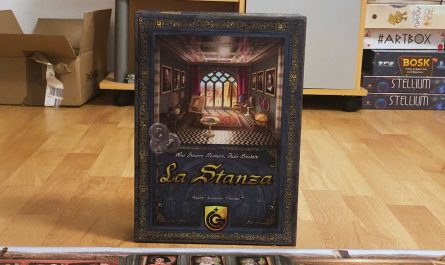For those readers who are a Greek mythology enthusiast, the word Ambrosia (ἀμβροσία) must have a familiar ring to you. While composing his masterpieces, Homer mentioned that exact word in Iliad and Odyssey. Intriguing is, not only this word represented the royal sustenance of the greedy Olympians, he used the expression to describe both the salve for the death and perfume. Many centuries later, the modern Ambrosia now defines the product of mixing nectar and pollen, which in general term is commonly known as honey. No wonder Skellig Games exhibited this game with such a title, especially when it bears one large bee on the cover.
Showcased during Spiel Messe in 2019, Ambrosia was then the second piece developed by Uwe Bursik (CMIIW). There are a few videos covering the tutorial and overview of the gameplay already, so we will not indulge in this matter further. It is nevertheless recommended to look up into it, to gain a better understanding of the game.
A short disclaimer before you read my board game analysis
As an avid euro gamer and hardcore Legend of the Five Rings (L5R) LCG player, my reviews may reflect a preference for these styles, and I may not cover solo games/variants extensively. Please note that my personal remarks are based on my gaming experiences, and I aim to provide honest insights within the scope of my preferences.
Bees are more than just the honey bees!
When the topic of honey comes up, and the bees, too, of course — it’s nothing few and far between that people tend to think about the honey bees. Well, that’s understandable, since Apis mellifera is the most common bee species found worldwide. Their fuzzy cousin, the bumblebee (not the robot one), is one of the most vital and most efficient pollinators. Most of the bee species are social, while 200 others prefer to live in solitary. For now, Ambrosia brings up the story of the social bee colonies, but perhaps, in the future, Uwe will explore the tale of their solitary counterparts in the future.
Christian Opperer illustrated the various species featured in Ambrosia. Each player takes control of a colony of one species, competing to pollinate and gather nectar in the meadow. In addition to the six regular worker bees, each player also gets a total of nine special ones. The illustration for the latter one has a comical twist, but it does the job to distinguish them from the normies. I appreciate Chris’ creativity in this regard.
By the way, the meadow mentioned previously serves as the playing board, which is shaped into a modular circuit. With this interchangeable meadow structure, Ambrosia can scale rather easily to accommodate different player counts. Within the meadow, bee colonies encounter various flowers with different Victory Points (VP) available to be collected. It is interesting to note how we score VPs in Ambrosia — which is also related to how we move and the game objective.
The gameplay: A bit counter-intuitive, yet interesting
I literally raised a smile after reading the rulebook and looking at the circular track in Ambrosia. The game reminded me of congklak, a game I frequently played during my childhood. This game has been passed down for centuries, and many Southeast Asian countries have different versions of how to play it. Western readers may be more familiar with its Arabic name Mancala. In congklak, we move the game pieces based on the number of them in the moving stack, which is where the similarity between Ambrosia and this ancient game ends.
In contrary to congklak, where players must move all tokens they pick from a space, in Ambrosia, players have the option to pick only some bees in a stack. These bees move over to one exact spot according to its number. For example, when I had a six-bee-stack, I could pick only five bees and move that new stack five spaces ahead, leaving one bee on the previous spot.
And unlike its ancestor, I didn’t have to leave one bee token on the spaces I’ve moved through. Dropping the new bee stack also came with several restrictions, whereas only available when the flower bed was empty, topped by our other bee tokens, or only by one bee token of the rivalling bee colonies.
It doesn’t sound so complicated, though? That would make scoring points easier, right? Well, I hate to break it to you, but scoring only happens when all your bee stacks cannot move any longer at all. This might be confusing at first, but you read it right — the real objective is to jam our colonies’ movement as soon as possible. When those bees still can fly, then we always need to move them around. My mindset when playing Ambrosia was, “How to wittingly get stuck, so I don’t have to take any move any more?” Contradictory against the common gaming objective and logic. When the bees cannot fly no more, we get the VP from all flower spaces with our visible bees on it.
A more pressing matter regarding scoring in Ambrosia is the timing. As mentioned above, we can top any alone opposing bee on a flower space — which may also happen to one of our bees. When our opponent surmounts his or her bees on ours, that particular will not be counted for scoring. It will also be ‘prisoned’ until they score and take all their bees after their scoring turn. More importantly, we require perfect timing to put the special bee on the particular spot to reap the most benefits. This particular timing needs a planning for not two, but perhaps even three steps ahead. There is definitely no luck involved in Ambrosia.
A Good catch-up mechanic and replay value in Ambrosia
Many of us happened to get frustrated when lagging — Uwe did implement a pretty solid catch-up mechanic to solve this problem. The Royal Jelly can be a helpful remedy to keep yourself in the race. Ambrosia, for example, rewards this resource for the last player scoring on each round. Furthermore, players can spend Royal Jelly to take two actions in a turn, which helps them to get stuck faster and score. Hence, the struggling last-place still have the chance to win, provided they still play for it hook, line and sinker.
With different setups for various player counts, Ambrosia also brings different strategy to the table. Playing with two players feel more like a different kind of chess. Each action is more meaningful and brings more weight. Meanwhile, with three or more requires better understanding of overall board situation. That means, reading the opponents’ next move is necessary.
Variability takes place not only from the different player count setup. Ambrosia comes with two-side boards, where the second side brings additional effects on all flowers to spice up the game. The simple rule cuts the time to learn and explain the game significantly, which means higher possibility of Ambrosia to be played multiple times afterwards, too.
Verdict
As mentioned, the way to win in Ambrosia was at first illogical. Getting used to it with one tutorial round would be a great warm-up. With this uncommon way to play, it’s easy to get in a very tight corner. Alas, Ambrosia is equipped with a good catch-up mechanic to push the lagging player — and thus, making it miles away from wild goose chase for them.
Ambrosia itself is not a complex game, despite its strategy depth. This aspect may be interesting for those who prefer lighter games in their arsenal, but not for those who seek for something more challenge. Granted, it has a unique gameplay, too — regardless, when you are used to something heavier, Ambrosia would pop up on your table once in a blue moon only.
Do you love board games as much as we do? Support us!
Thank you for reading our articles! If you enjoyed our work and want more captivating board game contents, make sure to:
👉 Follow us on our social media — you can find us on ![]()
![]()
![]() Click one of the icons to land on our social media, or find us @meepleeksyen there, it’s just a click away! Stay updated with our latest board game reviews and previews by following us on those platforms 📱👍
Click one of the icons to land on our social media, or find us @meepleeksyen there, it’s just a click away! Stay updated with our latest board game reviews and previews by following us on those platforms 📱👍
💬 Do you have contrasting opinions? Leave a comment — share your thoughts with us, we’d love to hear (or read) yours! Have you played this game before? Did you have something similar as well? Or perhaps, something more personal, like what are your favourite board games? Let’s discuss in the comments below!
🙏 Support Us! Your generous support can help us produce even better content in the future. If you love what we do, consider making a donation to our blog. Every contribution counts and means a lot to us! You can either donate locally with Indonesian Rupiah (IDR) via Trakteer ![]() or for international readers with another currency through Buy Me a Coffee
or for international readers with another currency through Buy Me a Coffee ![]() It helps us to survive, too! 💰 Click one of the button below 👇
It helps us to survive, too! 💰 Click one of the button below 👇
I am a full-time food technologist during weekdays. However, when the calendar hits weekends, I transform into an avid board gamer. I am a hardcore Legend of the Five Rings (L5R) LCG player from Fantasy Flight Games (FFG). Current hobby: buying board games. My shelf of shame’s list is getting longer, thanks to you, Kickstarter.





